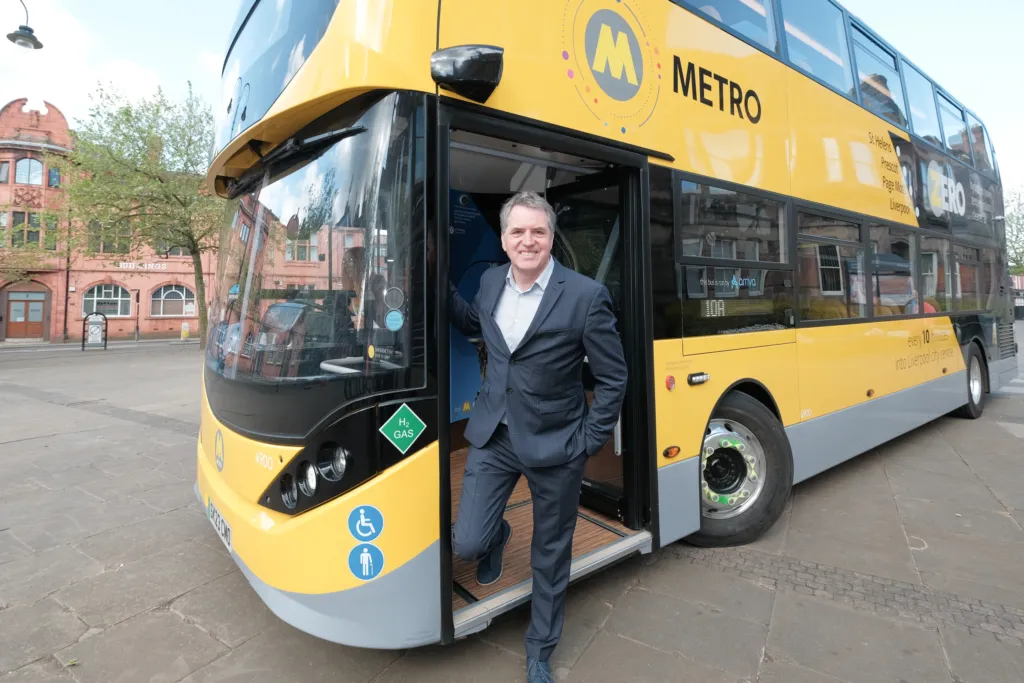Why are Merseyside’s state-of-the-art hydrogen buses stuck in a yard outside Sheffield?

The metro mayor's team insists they'll be back on the road soon – but others believe hydrogen has “fundamental issues”
Earlier this month, Tony was taking his seven-year-old cockapoo, Lola, for a walk. He’d left Toxteth for the weekend, and was staying with a friend in South Anston, a small town roughly 12 miles east of Sheffield.
As he and Lola strolled along Anston Brook, he happened to glance into a small manufacturer’s yard, next to a disused railway line. It was probably the bright yellow that caught his eye. Tony quickly realised he wasn’t the only one who’d made the trip from Liverpool to this quiet corner of South Yorkshire.
What Tony had stumbled upon was a fleet of some of the most state-of-the-art, expensive buses in the country: the famed Liverpool City Region hydrogen buses. Another couple of them were spotted a week later by a colleague on our Sheffield sister title, The Tribune, most definitely driving away from Liverpool.
The hydrogen buses were unveiled, with great fanfare, back in 2023. In press releases at the time, metro mayor Steve Rotheram stood proudly in front of the 20-strong fleet, launched as part of the Combined Authority’s plans to achieve net zero by 2040. Gone were the days of petrol and diesel; with this unveiling, Rotheram vowed the buses would become the “gold standard” in public transportation, bringing reliable London-style transport to the region. In total, the high tech fleet cost £10 million — or around half a million each.
Yet since their launch, very few people have got to enjoy a ride on one of these vehicles. After making just 450 passenger-carrying journeys they started facing problems. Sourcing enough hydrogen to power the buses quickly became difficult, hindering their usage across the region. Despite being active for less than two years, the Combined Authority confirmed all of the buses needed to undergo "testing and upgrade works" at "no cost to the local taxpayer", further delaying their appearance on our roads. Presumably this is why they’re in a yard roughly 80 miles from Liverpool — though when we asked the Combined Authority to explain what they meant by upgrade works, they didn’t provide further details.
We also asked the Combined Authority about when the buses will be returned to Merseyside and put back into use. They did not directly answer our question but told us: “We anticipate the buses will return to service following a short period of driver training, and we do not expect this to cause any disruption to passengers or timetables…As a city region, we’re committed to leading the way on transport decarbonisation. That includes exploring a mix of technologies – from hydrogen to electric – to ensure we can find the best solutions for our local network and futureproof our transport system”.
However, The Post has spent the last week speaking to members of the Combined Authority’s transport committee and specialist academics who have raised serious questions about the hydrogen-powered buses. “It’s what we call a science problem — we just don’t have the infrastructure or technology [in the UK] to meet hydrogen demands,” one academic told us, adding that there are "fundamental issues” that should have dissuaded the city region from buying into hydrogen in the first place. Some members of the transport committee blame Rotheram for this decision, with one telling The Post “he's quite susceptible to new toys”. So will the hydrogen buses get back on the road? Or are they condemned to sit, slowly rusting, just outside Sheffield?

Latest
A place in the sun: How do a bankrupt charity boss and his councillor partner afford a “luxury” flat abroad?
Gritty, cheeky, sincere: How Martin Parr captured the spirit of Merseyside
Liverpool’s hospitality scene is changing. So why are we reluctant to shout about it?
Breaking: Councillor Colette Goulding has been suspended
Why are Merseyside’s state-of-the-art hydrogen buses stuck in a yard outside Sheffield?
The metro mayor's team insists they'll be back on the road soon – but others believe hydrogen has “fundamental issues”